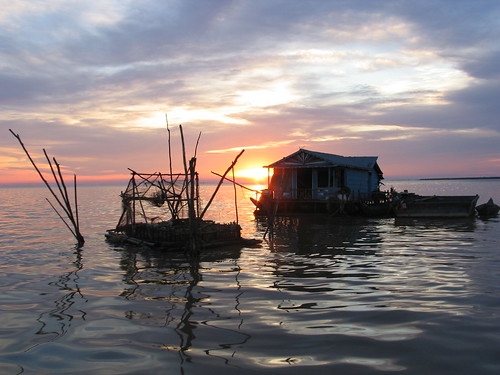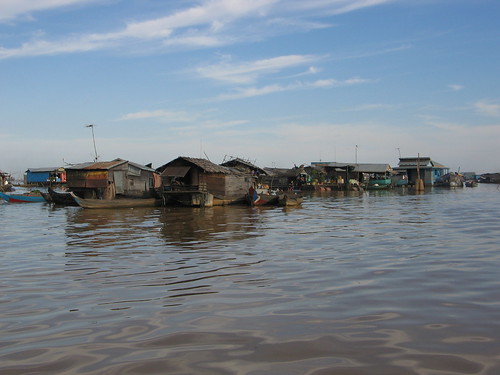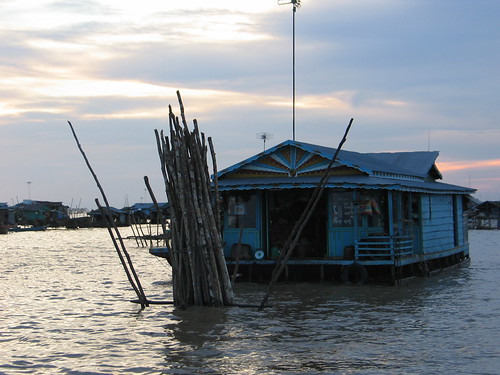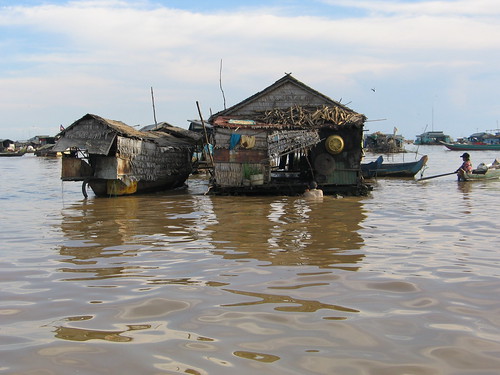
Tonlẽ Sap is the largest lake in Southeast Asia, fed by or, depending on the season, feeding the mighty Mekong River. The water level fluctuates from a depth of about 10 m in the wet season to 2 m in the dry and the lake nourishes a huge chunk of the region, providing a livelihood to thousands-upon-thousands. In an effort to lure visitors and their money away from Angkor Wat for awhile, the Cambodian government promotes trips to Tonlẽ Sap, particularly to visit the floating villages. These floating villages are just what the name implies, complete with schools, stores and churches. The tours are described as relaxing boat rides through a unique and picturesque waterscape. But when traveling it is often the height of naivety to expect all to be as it’s portrayed. And therein lays the fun.
After a sweltering day-and-a-half visiting the mind-blowing Angkor Wat complex, my friend and I decided to visit Tonlẽ Sap and Chong Kneas, the closest of all the floating villages to Siem Reap. We asked our friendly and reliable tuk-tuk driver (#2205) if he could take us to the lake and he assured us this was no problem. Soon we were rattling through dense traffic and endless road construction. Several times we had to get out and walk while the driver took the tuk-tuk off-road for brief stretches to get around obstacles. I inhaled more dust than I had over the previous 36 hours, which is really saying something. I dearly regretted not buying a cheap mask at the pharmacy as many people, locals and visitors alike, do. My throat was going to be sore for days.

Following a quick stop at the tuk-tuk driver’s house so he could drop off some fruit for his family, we were out of Siem Reap and into…something very different. Poverty on a large scale is always disarming, and the shacks and shanties on the road to the lake were the first indication that economics might be about to intrude on our scenic boat tour. We got to the boat launch about 4 pm and bought a ticket for a “government” boat (private boats are apparently available, but it’s not clear how to get them) with an extra “sunset” fee (i.e., a charge for staying on the water long enough to watch the sun go down). Thus began a very strange journey.
The entire floating village moves with the seasonal change in water level and, as the water was still quite low in the early spring, Chong Kneas was about as far out in the lake as it ever gets. Consequently, we had a long trip to the village, past all manner of boats, most patched up 10,000 times over with material of every description. Along the narrow channel leading into the lake dilapidated houseboats were moored everywhere possible and occasionally someone would be swimming in the filthy water. Had I dove in for a quick dip my immune system would’ve thrown up its hands in defeat and called it a day. Everything was totally fascinating and exotic and disturbing, as only 3rd world poverty can be. Immediately our gregarious guide started talking about how poor the people of Chong Kneas were and how they needed money for many things. I sensed a pitch coming on.

The village itself was an incredible array of dozens of ramshackle floating structures broken into Vietnamese, Muslim, and Cambodian sections. It looked more like a floating ghetto, perhaps, but it was difficult to gauge how comfortable the people were in their situation.


We sailed right over to the school where the kids were just getting out of class and into their own boats to go home. Inside we were introduced to the teacher and got our picture taken giving him the books and the pencils. Similar pictures of previous tourists lined the walls. We were told we could take photographs of some of the children. I asked one girl if she wanted her picture taken and she laughed and shook her head. I left her alone.

O ur guide then told us that the teacher could use some money to buy supplies for the classroom and extra food for the kids. I gave $10.00 to the teacher, who struck me as looking a little sheepish about the whole thing. On the way out I saw the French family getting out of their boat with a bag of notebooks and pencils.

Next we headed through the village and boarded a restaurant boat complete with an on-board crocodile farm and some voracious fish in a wooden tank. We decided to pass on the dinner. After a tour of the boat and a little biology/geography lesson, we were sold a can of soda and then sat down at a table with a well-spoken and very effeminate fellow, a self-proclaimed ladyboy, who told us he loved Pelẽ, Brazilian football and WWF Smackdown. He and our guide seemed to be friends, although our guide went out of his way to appear annoyed with him.
After awhile we climbed up some stairs and checked out the view from the top of the boat. The floating village was spread out before us, the sun slowly sinking into Tonlẽ Sap. We decided to head out early in order to get some photos from the water before the sun set completely. There was a slight delay as we helped out a boat with a dead battery. The family in the boat was clearly unhappy with the way their trip had been going. They were making no bones about it. It was hard to have much sympathy for them.

We sailed out past people fishing and washing from the porches of their houseboats in the muddy-brown water. There were a few bonfires burning off on the shore. As we made our way back through the channel our guide said the Cambodian government had plans to make the entire area a world-class shipping port, essentially eliminating all that we saw around us. Lord knows how this would work. For one thing, they’d have to do considerable work to stabilize and dredge the lake as its area swings wildly from 3,000 to 10,000 sq. km and it can be very shallow, depending on the season and rainfall. Yet there was evidence of construction on the banks nearby.
By the time we returned to shore it was pitch dark. Our guide mentioned that he needed money for school and was very disappointed when I said I didn’t have much left. I scrounged up $5 for him and $2 for the driver. I considered telling the guide he should’ve pitched less for everyone else if he wanted something for himself. How much of this was a scam I have no idea. Other tours are advertised, but they seem pretty cheesy and are mostly billed as “dinner tours.” Maybe the schoolteachers and the boat guides are in cahoots and splitting the proceeds. Maybe the government is taking the money and using it for its own purposes. Or--who knows?--maybe it’s legit. But it’s hard to imagine there’s not some skimming somewhere. All told, this was probably a $50.00 ride by the time it was over.

In reality, the village is spectacular and unusual, even if disconcerting. And I was happy that I had a look at Chong Kneas, despite the lingering feeling of being ripped-off. But I thought back to the previous day in Angkor Wat, when a young boy tried to sell me a bootleg guide to the temples. At first he said the book was one dollar. “One dollar?” I asked. I could afford that. “No, three dollars,” he said. I hesitated. “Five dollars,” he continued. This was a very unusual business tactic. “What happened to one dollar?” I asked. “It can’t be less than five,” he replied. He was probably working under the instructions of whoever supplied the books. “I can’t afford five dollars,” I said. “I don’t have any money.” This was technically true as I was traveling my way deeper into debt with every step, but the kid was having none of it. His eyes hardened and he glared up at me. “You are from America. You have come to Cambodia. You have money. I will wait until you are ready to leave the temple and then you will buy the book.” I laughed but he did not. So I walked around for awhile and on my way out, sure enough, there was the kid with his book. I handed him the $5 and he grumbled his thanks and walked off. In travel, as in life, sometimes you have to let yourself be ripped-off a little. It’s only fair.
